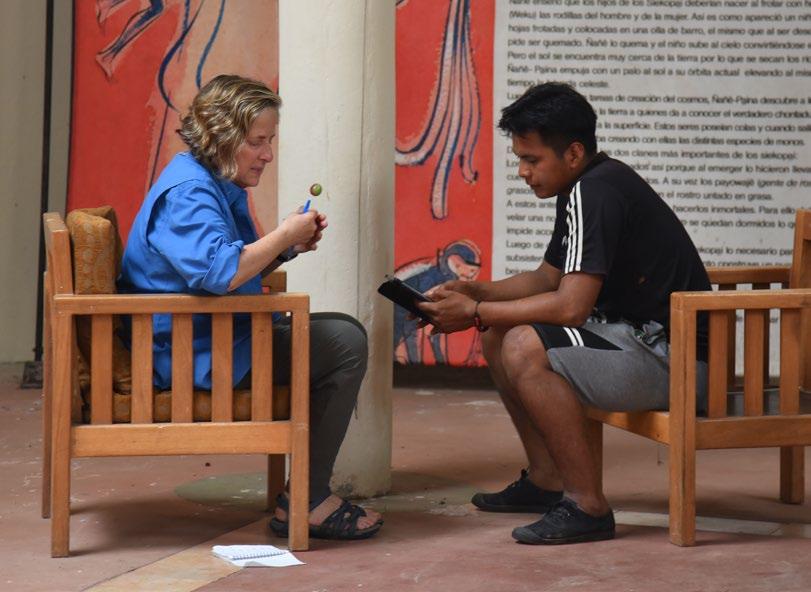
5 minute read
Field visit facilitates next steps in NSF-funded research on biocultural heritage
Research team works with Indigenous partners in Ecuadorian Amazon on social science surveys for local communities
On the copper-colored waters of the Aguarico River in northeast Ecuador, a dugout canoe motors against the current, just departed from the remote Siekopai community Remolino after a research visit with its residents. Not ten minutes into the hour-long journey, the skies burst open and lash down curtains of rain. Before long, the drenched team has to stop and bail out water before they can continue—the first of two such interruptions. “We took it in stride,” laughs Center affiliate professor Cynthia Simmons (Geography), three weeks after returning to Gainesville. “It’s the wettest part of the Amazon, so it’s not a surprise.”
Advertisement
Along with Colorado State University professor Joel Correia, Dr. Simmons spent two weeks in the region as a part of their NSF-funded research project to study Indigenous socio-environmental systems there. The team is led by Principal Investigator and Center professor Robert Walker; along with Drs. Simmons and Correia, Center affiliate professor Miguel Acevedo (Wildlife Ecology and Conservation) and Princeton University researcher Michael Esbach (PhD, University of Florida) are Co-Principal Investigators.

During this latest field visit, Drs. Simmons and Correia met with communities along the shores of the Aguarico to train local representatives on a social science survey that they will use to conduct interviews with community members after the U.S. researchers leave. The results of these surveys will then be synthesized with ecological data collected by the team as part of their integrated, transdisciplinary research design. “Our approach draws from the concept of biocultural heritage, which views the relationship between the social and ecological as intimately integrated,” explains Dr. Correia. “But that relationship isn’t binary; rather, it’s a web of dynamic systems and processes that are embedded within broader political and economic forces, too.”
By collecting both social and ecological data, the researchers seek to reach a more nuanced and complex understanding of how these systems interact with one another, especially in the larger context of encroaching extractive development that threatens the biocultural heritage of these communities. “The complexity of the questions and problems and dynamics that we’re investigating—and that people are navigating in their daily life—requires a complex approach,” Dr. Correia. “Having a team of people bridging the boundaries of their disciplines is a necessity.”
Integrating social science with environmental research points to another crucial feature of the project: working with Indigenous communities on equal terms as respected partners, not research subjects. Before the trainings even began, the surveys were workshopped with community members, to ensure that the questions respond to their interests and are culturally appropriate. They were then carefully translated into the different local languages—a collaborative process that took several days. At all stages of the project, the activities are designed to build Indigenous research capacity.
Both Drs. Simmons and Correia emphasize that this type of fieldwork is only possible because of years of relationship development—in this case, thanks in large part to the trust built by co-investigator Michael Esbach during his years of research in the area. “Many Indigenous communities are understandably very hesitant to receive researchers, especially when the projects don’t offer any benefit to them,” Dr. Simmons explains. “Michael’s work has been profound in fostering trust in this project.”

To ensure one particular benefit for the Siekopai, Sinangoe, Siona, and Zabalo communities participating in the project, the U.S. team collaborated with them to create data sovereignty agreements, by which they have full access to the data the project generates and how that data is used or published in the future. This model facilitates a larger purpose for the project: to identify and support strategies for community-led conservation in the future. “Our work has the potential to demonstrate that there really is that connection between Indigenous cultures and their environment, which may be able to support their claims to territory,” Dr. Simmons explains. With Indigenous communities across Latin America under threat, whether by road construction, monoculture farming, oil extraction, or wildlife poachers, resources like legal evidence or early warning about harmful developments may be vital in the keeping their territory intact.
Going forward, the team will continue periodic field visits to work with the community partners and collect data. The next stages of the project will involve Dr. Acevedo leading the analysis of ecological data and Dr. Walker integrating the findings in order to test hypotheses about the sustainability of Indigenous Territories.
This field trip complete, Drs. Simmons and Correia underscore the importance of going to the field sites and interacting with the communities firsthand. Even with the soaking rainstorm, both of them cited the excursion to Remolino as their favorite activity on the trip.
“The community was so excited to have us there, and so incredibly generous,” says Dr. Simmons. “It was such a great experience, creating that bond.”
“For me, research is always about interpersonal relationships,” Dr. Correia notes. “At the end of the day, the most important facet of this work is that it supports communities and their goals, because they’re the ones living in these contexts and confronting these challenges after we leave. So every trip, it’s about deepening relationships, spending time with people, and trying to use the tools we have at our disposal to meet those challenges.”










